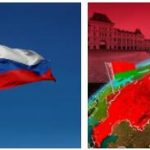Belarus is an Eastern European country. Situated in the Plain of Northern Europe, it covers an area of 207 600 km 2 . Belarus is bordered by Latvia in the north, Russia in the east, Ukraine in the south, Poland in the west and Lithuania in the northwest. The main cities are Minsk, the capital, with 1,695,000 residents (1995), Brest, Homel (514,000 residents), Orsha and Mahilyow (366,000 residents).
The climate is continental, with cold winters and mild, rainy summers.
Economy
Most of the country’s territory is occupied by forests. In agricultural terms, the dominant crops are potatoes, beets, flax, vegetables, wheat and fruits. Belarus is poor in mineral resources, although it has considerable potassium deposits. There are some reserves of oil and natural gas. The industry includes the production of chemical fertilizers, building materials, plastics, paper, fabrics, television and radio receivers, computers, watches, bicycles and tractors. The main destinations are Russia, Ukraine, Poland and Germany, and are mainly made up of trucks, synthetic fibers, refrigerators, tires and fertilizers.
Population
The population of Belarus is 10,293,011 residents (2006), which corresponds to a density of 49.62 residents/km2 . The birth and death rates are, respectively, 11.16% and 14.02%, which implies a downward trend in the population, which, in 2025, is estimated to reach 10 135 000 residents. Average life expectancy is 69.08 years. Belarusians represent 78% of the population, followed by Russians (14%) and Ukrainians (3%). The religion with the greatest expression is Orthodox Christianity. The official language is Belarusian although Russian is also spoken.
History
In the 13th century, what today corresponds to Belarus was incorporated in Lithuania and, in 1569, it was united to Poland. In the 18th century, with the three partitions of Poland, Russia conquered the entire territory to which it named Belarus. Until the 19th century, the region did not develop economically. Between 1918 and 1921, the country was disputed between Germany, the Russian Bolshevik Government and Poland. Some western regions were eventually transferred to Poland by the Bolsheviks. However, in 1919, Russia proclaimed the Soviet Socialist Republic of Belarus which, in 1922, became part of the Soviet Union. In the 1930s and 1940s, the country experienced strong industrialization. At the end of the Second World War, the country experienced extreme poverty, in addition to the deaths caused by the war. At that time, the Soviet Government reconquered the western areas that had been under Polish administration since 1921. Immediately thereafter, the territory underwent massive reconstruction. From the 1980s, the central authority of the Soviet Union began to weaken and, in July 1990, Belarus declared its sovereignty and, consequently, independence, in August 1991. With the dismemberment of the Soviet Union in December of the same year, the country achieved full independence. Still in 1991, it joined the Commonwealth of Independent States (CIS). Belarus declared its sovereignty and, consequently, independence, in August 1991. With the dismemberment of the Soviet Union in December of the same year, the country achieved full independence. Still in 1991, it joined the Commonwealth of Independent States (CIS). Belarus declared its sovereignty and, consequently, independence, in August 1991. With the dismemberment of the Soviet Union in December of the same year, the country achieved full independence. Still in 1991, it joined the Commonwealth of Independent States (CIS). For Belarus democracy and rights, please check intershippingrates.
- Countryaah.com: Offers a full list of airports in the country of Belarus, sorted by city location and acronyms.
- Abbreviationfinder.org: Provides most commonly used abbreviations and initials containing the country name of Belarus. Listed by popularity.
1UpTravel.com – Maps of Belarus
Browse a collection of country, political, shaded relief and thematic maps of this European country. Check out the map of major defense industry facilities in Belarus.
Website: http://www.1uptravel.com/worldmaps/belarus.html
Belarus – InfoPlease.com Map
View a high-definition graphical map of Belarus and locate key cities and surrounding countries.
Website: http://www.infoplease.com/atlas/country/belarus.html
Belarus – Merriam-Webster Atlas
Detailed color map of this former Soviet republic. Also get country facts, illustration of the nation’s flag, and a historical summary.
Website: http://www.m-w.com/maps/belarus.html
Belarus – National Geographic Map Machine
Provides an expandable map of the former Soviet republic. Includes geographical highlights and a brief statistical overview.
Website: http://plasma.nationalgeographic.com/mapmachine/index.html?i
Belarus – Theodora.com
Two maps of the former Soviet republic. Click on the map to get a bunch of country facts and information.
Website: http://www.theodora.com/maps/belarus_map.html
Belarus – University of Texas Library
Provides a collection of country and specialty maps, including one showing radiation hot spots resulting from the Chernobyl accident.
Website: http://www.lib.utexas.edu/Libs/PCL/Map_collection/belarus.ht…




